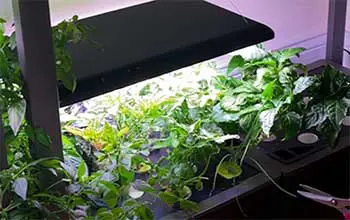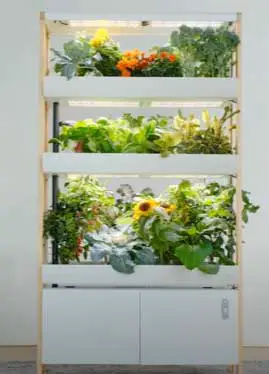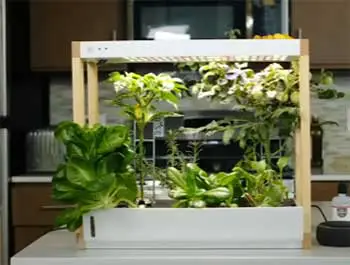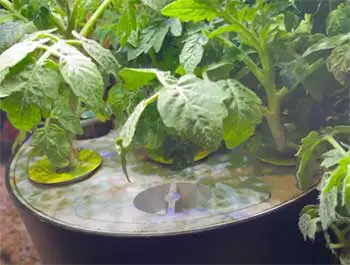Indoor gardening has become an extremely popular hobby and passion for many over the last few years. The ability to grow fresh herbs, vegetables, fruits, and flowers right in your own home is game-changing.
You can now experience the joy and satisfaction of producing your own healthy harvests even without an outdoor garden.
Hydroponic indoor gardening systems are at the forefront of making this home-based farming revolution possible. Leading the way are two major brands – Rise Gardens and AeroGarden. Both allow you to cultivate plants indoors without soil through automated, hydroponic systems.
But which is better – Rise Gardens or AeroGarden?
In this comprehensive guide, we’ll compare these two top hydroponic indoor garden systems in depth. We’ll examine all the key features, benefits, drawbacks, specs and offerings to help you determine which is right for your gardening needs and environment.
A Brief Comparison Table
| Specs/Features | Rise Gardens | AeroGarden |
| Grow Height | Up to 36 inches | 12-24 inches |
| Grow Light | Full spectrum LED | Full spectrum LED |
| Light Intensity | 600 watts total across 2 light bars | 45 watts (Bounty models); 30 watts (Harvest models) |
| Grow Space Footprint | 25”L x 16”W x 59”H (largest model) | 20” diameter (Bounty); 11” x 11” (Harvest) |
| Reservoir Capacity | 3-5 gallons | 1.3-5 gallons |
| High-Tech Features | Rise app control, camera monitoring | AeroGarden app control, Alexa compatibility |
| Price Range | $449 – $829 | $99 – $599 |
Rise Gardens Overview

Rise Gardens focuses on the higher end of the hydroponic indoor gardening market. Their systems feature sleek, contemporary design using materials like bamboo, aluminum, and powder-coated steel along with large touchscreen controls.
Rise Gardens promises powerful full spectrum LED grow lights, large capacity reservoirs, and sophisticated smartphone app controls. Their hydroponic systems are relatively new to the market compared to AeroGarden, which has greater brand recognition and maturity.
Currently Rise Gardens offers just two main models – the Rise Garden Junior and Rise Garden XL:
Rise Garden Junior
- Accommodates 3 plants
- 25″ tall growing capacity
- 34 watt LED grow light
- 3 gallon water reservoir
- MSRP $449
Rise Garden XL
- Accommodates 9 plants
- 36″ tall growing capacity
- 600 watt LED grow light
- 5 gallon water reservoir
- MSRP $829
Rise Gardens focuses on a clean, contemporary aesthetic using bamboo or solid walnut for the bases along with powder coated steel and aluminum frames. Their systems take up slightly more floor space but provide much greater vertical grow height than most AeroGarden models.
Monitoring and controlling your Rise Garden remotely is easy with their smartphone app. It allows you to check system stats, receive alerts, customize lighting schedules, and operate a built-in camera to monitor plant growth.
AeroGarden Overview

Aerogarden is by far the most established brand name in indoor hydroponic gardening systems.
They’ve been producing self-contained, soil-free indoor gardens since 2006 and have the product selection to show for it.
AeroGarden sets themselves apart by optimizing for affordability and ease of use.
Their product line ranges from compact 3-plant countertop models to large gardens accommodating up to 24 plants.
Here is a quick overview of the core AeroGarden models and specs:
Harvest:
- 3 plant capacity
- 12” grow height
- 20 watt LED grow light
- 1.3 gallon reservoir
- MSRP $99.95-$149.95
Harvest Elite:
- 6 plant capacity
- 12” grow height
- 20 watt LED grow light
- 1.3 gallon reservoir
- MSRP $149.95-$199.99
Bounty:
- 9 plant capacity
- 24” grow height
- 45 watt LED grow light
- 3.8 gallon reservoir
- MSRP $349.95-$399.95
Bounty Elite:
- 9 plant capacity
- 24” grow height
- 45 watt LED grow light
- 3.8 gallon reservoir
- MSRP $549.95-$599.95
Farm Plus:
- 24 plant capacity
- 12” grow height
- 30 watt LED grow light
- 5 gallon reservoir
- MSRP $599.95
AeroGarden’s have an exterior made primarily of plastic rather than wood or metal. While not as stylish, the plastic contributes to more affordable pricing. Their lights and pumps are also integrated directly into the main unit for compactness rather than separate hardware pieces like Rise Gardens.
Key Differences Between Rise Gardens And AeroGarden Hydroponic Indoor Gardens
Now that we’ve covered the basics of what each brand offers, let’s do a detailed comparison of their key strengths and weaknesses.
- Design and Aesthetics
One of the first differences you’ll notice between Rise Gardens and AeroGarden models is the design language and materials used.
Rise Gardens Design
Rise Gardens feature a contemporary design aesthetic utilizing materials like bamboo, aluminum, and powder coated steel. The bamboo or walnut bases combined with slimline steel accents results in an upscale, minimalist look.

The Junior model stands 25 inches tall while the XL reaches up to 59 inches high to accommodate larger plants.
The XL weighs in at 40 pounds including its 5 gallon reservoir while the Junior model is just 25 pounds when empty.
Rise Gardens come in neutral white and black color options to blend seamlessly into modern decor.
The prominent LED light bars and touchscreen controls resemble what you might see in a high-tech office rather than a traditional indoor garden.
Overall, Rise Gardens aims for a sleek, contemporary statement piece that looks just as at home in your living room as a kitchen.
AeroGarden Design
In contrast to Rise Gardens, AeroGarden models employ a simpler, plastic-heavy design focused on utility over aesthetics. Their systems resemble kitchen appliances more than furniture with primarily off-white and black color schemes.
The compact Harvest models have a unique orb shape while the larger Bounty and Farm models use rectangular plastic housings. Dual-arm LED light fixtures extend over the grow basin rather than the standalone light panels used in Rise Gardens.
AeroGarden’s exterior plastic shells are purely functional and won’t win any interior design awards. However, the simpler design contributes to more budget-friendly pricing for AeroGarden systems versus the premium costs of Rise Gardens.
If stylish design is a priority, Rise Gardens certainly delivers more of a contemporary, furniture-like look. But AeroGarden’s functional, value-driven aesthetic appeals to those who just want simple indoor gardening without breaking the bank.
- Size Options and Grow Capacity
When it comes to size options and plant growing capacity, AeroGarden clearly has the upper hand over Rise Gardens.
Rise Gardens Sizes
Rise currently offers just two models – the Rise Garden Junior and Rise Garden XL.
The Junior can accommodate 3 plants while the XL bumps capacity up to 9 plants. This means you can currently only choose between small and large options with no middle ground.
The Junior stands at 25 inches tall while the XL reaches up to a full 59 inches in height. This allows you to grow a nice variety of small to large vegetables compared to most AeroGarden models.
Still, Rise Gardens trails AeroGarden substantially when it comes to sizing flexibility. Two options make it less convenient to “right size” your garden based on your space constraints and plant count needs.
AeroGarden Sizes
Thanks to their wider product selection, AeroGarden provides 5 distinct models to choose from accommodating anywhere from 3 to 24 plants.
Their Harvest, Harvest Elite, and Bounty models are meant for tabletop use with relatively small footprints. While the height is limited to 12-24 inches, the wider surface areas can hold 3-9 plants in a compact space.
Stepping up to the Farm Plus model gets you a massive 24 plant capacity while taking up just 3 by 2 feet of floor space.
AeroGarden’s range of sizes makes it easy to start small with just a 3-plant system on your kitchen counter. You can then scale up to larger units holding 9, 12, 18 or 24 plants as your indoor gardening ambitions grow. The sizing flexibility is unmatched by Rise Gardens currently.
- Lighting Power and Technology
One of the most important factors for indoor gardening is providing sufficient light to fuel plant growth through photosynthesis. Both brands use full spectrum LED lighting tuned to the wavelengths plants need. But there are big differences when it comes to lighting power and coverage.
Rise Gardens Lighting

Rise Gardens pride themselves on the high intensity lighting built into their systems.
The Junior model may be compact but still outputs 34 watts of power from an overhead LED light bar.
But it’s the Rise Garden XL that really brings the heat when it comes to lighting with a whopping 600 watts of power – 200X brighter than a standard 3 watt LED bulb!
The 600 watts are spread across two adjustable light bars using full spectrum Samsung LED diodes. This intensity allows you to grow large, fruiting vegetables like tomatoes that require abundant light. Rise Gardens definitely leads the way in lighting power.
AeroGarden Lighting
AeroGarden lighting takes a more conservative approach optimized for efficiency and value. Their Harvest and Harvest Elite models use 20 watt LED grow lights. Stepping up to the Bounty and Bounty Elite bumps that to 45 watts.
Even the largest Farm Plus AeroGarden model tops out at just 30 watts for its lighting system. That’s still hundreds of watts dimmer than Rise Gardens’ XL model sporting 600 watts of illumination.
While AeroGarden’s lighting setups are likely sufficient for compact herbs and greens, the lower wattages do limit what you can grow successfully. You’ll have a harder time with light hungry vegetables versus Rise Gardens’ brilliance.
If you want the maximum flexibility to grow fruits, large vegetables and taller plants, Rise Gardens is the clear winner when it comes to providing serious light power. AeroGarden makes some tradeoffs on lighting intensity to meet lower price points.
- Self-Watering Systems
Eliminating the need to manually water your plants is one of the major advantages of hydroponic indoor gardens. Both brands use self-contained water reservoirs that irrigate plants automatically based on scheduled cycles. But there are some notable differences in reservoir size and pump technology.
Rise Gardens Watering System
The Junior model features a 3 gallon reservoir while the larger XL bumps capacity up to 5 gallons. For reference, the XL reservoir is about 3-4x as large as most entry-level AeroGarden models.
Rise Gardens uses quiet aquarium-style water pumps to irrigate plants without noisy vibrations or gurgling. The water is pumped over the exposed root systems on a timed cycle to provide the moisture plants need while minimizing water waste.
Larger reservoir capacities mean less frequent refilling for you. Rise Gardens’ tanks can hold enough water to irrigate your plants for weeks at a time rather than days between refills.
Their companion app also provides notifications when it’s time to add more water so you don’t need to keep a mental timer. Overall, the Rise Gardens self-watering systems provide some of the largest capacities and quietest operation on the market.
AeroGarden Watering System
AeroGarden models employ simpler air pump-based irrigation rather than water pumps. Air stones release air bubbles into the water, which then act as the force to carry water into the grow deck area.
Reservoir capacities range from just 1.3 gallons on the Harvest models up to 5 gallons on the Farm Plus. That puts even the largest AeroGarden well behind Rise Gardens’ 5 gallon XL model.
The downside to air pump systems is they can generate noticeable gurgling noises that some users find disruptive. However, the systems are inexpensive and effective for the most part.
Filling the reservoirs less often is definitely an advantage of Rise Gardens greater capacities. But AeroGarden’s systems still automate the watering process itself, freeing you from daily watering chores.
- Grow Height
How tall of plants can you cultivate in an indoor garden? Grow height capabilities typically dictate what you can raise successfully.
Rise Gardens Height
One major advantage Rise Gardens touts is greater vertical grow space versus AeroGarden. The Junior model provides 25 inches of height capacity while the XL maxes out at 36 inches.
This gives you plenty of headroom for larger vegetables like full-size tomatoes and peppers. You can also grow long trailing herbs and leafy greens that would otherwise get cramped and leggy.
AeroGarden Height

On the flip side, AeroGarden models have more modest grow heights.
The Harvest models allow just 12 inches for plants while the Bounty series extends to 24 inches tall.
Even AeroGarden’s largest Farm Plus model tops out at 12 inches in height while holding 24 plants.
The short ceiling means you’ll need to stick to growing smaller herbs, lettuces, and compact vegetable varieties.
For those who want the most flexibility to grow larger, trailing veggies and flowers, Rise Gardens is the clear winner on vertical plant capacity. AeroGarden does better for those focused exclusively on leafy greens and petite herbs that don’t require as much overhead space.
- Smart Garden Features and Automation
Both brands offer mobile apps and some degree of automation when it comes to controlling lighting schedules and monitoring garden conditions. But Rise Gardens pulls ahead when it comes to high-tech functionality.
Rise Gardens Smart Features
Rise Gardens include built-in WiFi and Bluetooth connectivity to enable communication with your mobile device. Their app (available for iOS and Android) allows you to control lighting times, intensity, and spectrum from anywhere.
You can set custom schedules to mimic sunrise, sunset, and daytime conditions optimally geared for your plants. Temperature and humidity sensors convey ambient conditions of your garden through the app as well.
Rise also includes front-facing cameras in their grow lights pointing down at your plants. This lets you visually monitor growth and catch emerging issues early through the app.
In addition, the app sends you notifications when it’s time to add more water or plant food. All of these automations and remote capabilities add high-tech convenience that busy indoor gardeners need.
AeroGarden Smart Features
The AeroGarden lineup also includes free companion apps with some nice perks but not quite the breadth of Rise Gardens. Available for iOS and Android, the app allows you to manually control lighting schedules and durations.
It provides updates on plant growth stages, notifications for adding water and food, and light adjustment capabilities. You can also ask Amazon Alexa or Google Assistant to verbally control the lights and garden operations if you don’t want to dig out your phone.
One downside is a lack of onboard cameras for remote visual monitoring. AeroGarden does partner with third-party camera accessories but the integration is clunky compared to Rise’s slick built-in cameras.
For those who really want to geek out on smart gardening capabilities, Rise Gardens is tough to beat. But AeroGarden still offers very useful mobile controls and automation for the average user.
- Nutrient Delivery Systems
The essential macronutrients and micronutrients that plants need come from proprietary soluble plant foods used by both brands. Rather than messy liquid fertilizers, the nutrients come in powder or pod form.
Rise Gardens Nutrients
Rise Gardens offer two Concentrated Plant Nutrient Formulas specifically designed for their systems – one for leafy greens and one for fruiting plants like tomatoes. The powders are mixed into the reservoirs to infuse the water with nitrogen, potassium, phosphorus, and essential minerals.
Rise plant food bags provide around 60 days worth of nutrients. Their mobile app reminds you when it’s time to replenish.
AeroGarden Nutrients
Rather than powders, AeroGarden uses pre-measured plant food pods to simplify nutrition even further. The sealed podsPromise their pre-seeded seed pods dissolve over time to release nutrients tailored to each growth stage.
The pods come in 30 day supplies with indicators to remind you when they are depleted. AeroGarden also sells optional liquid nutrients if you prefer going that route.
Either way, both indoor garden systems spare you the complicated work of formulating fertilizers yourself. Simply use their purpose-made nutrients engineered specifically for hydroponic plants.
- Seed Pods
In addition to nutrients, AeroGarden has a big advantage when it comes to seed pods that kickstart your indoor garden.
Rise Gardens Seeds
Rise Gardens currently does not offer their own pre-seeded seed pods. That means you need to acquire seeds separately and handle the planting process yourself.
This gives you more flexibility and variety in what you grow. But it does involve extra effort upfront that beginners may find daunting.
AeroGarden Seeds
AeroGarden has pre-seeded seed pods down to a science. Their pods come with biodegradable grow media embedded with non-GMO seeds. Just add water and let the pods do the work from there.
The seed pod kits come pre-matched with a month’s supply of nutrients tailored to each plant type. Choices range from heirloom salad greens, culinary herbs, cherry tomatoes to flowering plants.
AeroGarden’s seed pods make startup dead simple even for total gardening newbies. Just add water and let the automated lighting and nutrient dosing take care of the rest. It takes a lot of the intimidation and challenge out of DIY indoor gardening.
However, sourcing your own seeds does provide more flexibility and customization as your skills improve. But AeroGarden’s straightforward seed pods are perfect if you value pure simplicity, especially when getting started.
Comparison of Maintenance Requirements
While hydroponic gardens automate the hard parts like watering and lighting, some periodic maintenance is still required. Here’s an overview of the main upkeep needs for Rise Gardens and AeroGarden systems:
Rise Gardens Maintenance
- Adding water to the reservoir every 2-4 weeks
- Replenishing concentrated plant nutrients every 1-2 months
- Testing and adjusting pH every 4-6 weeks
- Pruning and thinning plants as needed
- Wiping down leaves to prevent pathogens
- Cleaning pump filter every 3-6 months
AeroGarden Maintenance
- Adding water to reservoir every 1-2 weeks
- Replacing pre-seeded pods every 2-3 months
- Replenishing plant food pods monthly
- Pruning and thinning plants
- Wiping down leaves
- Replacing grow lights annually
I would like you to watch this vide before you proceed.
While the maintenance needs are very comparable, AeroGarden’s smaller reservoirs do require refilling more frequently. Both brands combat algae growth by fully enclosing the water tanks and irrigation systems.
Overall, the periodic maintenance is reasonable and worth it for the reward of home-grown produce and herbs conveniently at your fingertips.
Cost Comparison
Last but certainly not least – how do costs stack up between Rise Gardens and AeroGarden models?
- Rise Gardens Pricing
As the premium offering targeting high-end consumers, Rise Gardens come at a price. The Junior 3-plant model retails for $449 while the 9-plant XL model jumps up to $829.
The contemporary design and advanced technology command top dollar. Ongoing costs include purchasing Rise plant food refills and replacement parts as needed.
- AeroGarden Pricing
The key advantage of AeroGarden is affordability across their product selection. Their Harvest models start at just $99 for a 3-plant countertop unit. Even the high-end Bounty Elite model rings in at $599.
Ongoing costs include new seed pods every few months and monthly plant food pods. Grow light bulbs need replacing yearly as well. But the total lifetime costs remain very reasonable relative to Rise Gardens.
For those on a tight budget who still want to enjoy the benefits of indoor gardening, AeroGarden provides excellent value at every price tier. Rise Gardens cater more exclusively to premium shoppers willing to pay for standout aesthetics and performance.
Frequently Asked Questions (FAQ)
Based on reviews and ratings, some of the best hydroponic gardens are AeroGarden, Rise Gardens, Lettuce Grow, and Click & Grow. AeroGarden is one of the most affordable and beginner-friendly options, while Rise Gardens offers more high-end features. Lettuce Grow and Click & Grow also make quality self-contained hydroponic systems.
The AeroGarden Harvest is considered one of the best indoor garden kits for beginners thanks to its affordable price, compact size, and easy pre-seeded pod system. Rise Gardens also get high marks but come at a higher price point. Most kits provide the lighting, pumps, nutrients and basic accessories needed to get started.
For most users, AeroGardens are absolutely worth the investment. Their reasonable cost and ability to deliver fresh herbs, greens, and veggies year-round provide great value. They make indoor gardening simple even for those lacking time and gardening experience. Ease of use and the joy of growing your own produce make AeroGardens a worth while purchase for many.
The AeroGarden Harvest is the best indoor garden for beginners. It’s affordable, compact, and comes with pre-seeded pods that automatically grow herbs and salad greens with just the addition of water and plant food. The included preset schedules and app make gardening easy for beginners. Rise Gardens and Click & Grow are also good for beginners who want more advanced features.
Wrapping Up
When comparing Rise Gardens and AeroGarden hydroponic systems, both have their advantages and best use cases. AeroGarden is ideal for beginners seeking affordability and compact size.
Rise Gardens caters to advanced gardeners with more contemporary design and power.
Consider your budget, desired features, and types of plants you want to cultivate indoors. This will steer you towards the best hydroponic garden option for enjoying home-grown, garden-fresh produce year-round.
